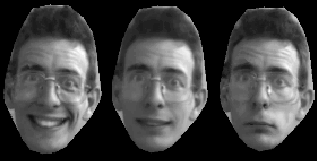Combined Appearance Models
We can model the shape change of an object using a
Statistical Shape Model.. We can use a similar statistical model
to represent the intensity variation across a region. Given a set of
training images, labelled with landmark points, we can use image warping
to deform each image so that the object has the mean shape, then build
a statistical model of the grey-levels across the object.
We can then use the shape and grey-level parameters to synthise new
examples. Given a set of grey-level parameters, we generate the
grey-level image with a mean shape. We then warp that image to
match the shape defined by the shape parameters.
Of course, in many cases the shape and grey-level parameters will
be correllated, and we can build a model to represent this. For
instance, we have built a model of the appearance of my face. Here
is one of the modes of combined shape and grey-level appearance:
 (The central image is the mean)
Here are a few example modes from a colour model generated by Gareth Edwards
(The central image is the mean)
Here are a few example modes from a colour model generated by Gareth Edwards


 Such models can be fit to new images using the
Active Appearance Model algorithm.
Such models can be fit to new images using the
Active Appearance Model algorithm.
You can now download a set of tools to build and play with
Appearance Models and AAMs here. Enjoy.
Tim Cootes
 (The central image is the mean)
Here are a few example modes from a colour model generated by Gareth Edwards
(The central image is the mean)
Here are a few example modes from a colour model generated by Gareth Edwards


 Such models can be fit to new images using the
Active Appearance Model algorithm.
Such models can be fit to new images using the
Active Appearance Model algorithm.